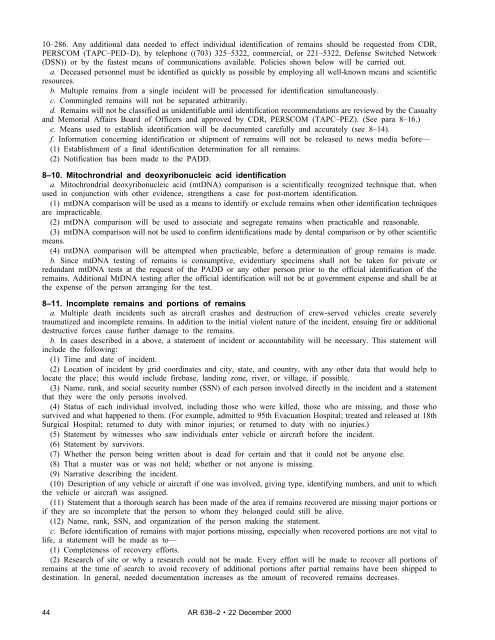Care and Disposition of Remains - Army Publishing Directorate ...
Care and Disposition of Remains - Army Publishing Directorate ...
Care and Disposition of Remains - Army Publishing Directorate ...
Create successful ePaper yourself
Turn your PDF publications into a flip-book with our unique Google optimized e-Paper software.
10–286. Any additional data needed to effect individual identification <strong>of</strong> remains should be requested from CDR,<br />
PERSCOM (TAPC–PED–D), by telephone ((703) 325–5322, commercial, or 221–5322, Defense Switched Network<br />
(DSN)) or by the fastest means <strong>of</strong> communications available. Policies shown below will be carried out.<br />
a. Deceased personnel must be identified as quickly as possible by employing all well-known means <strong>and</strong> scientific<br />
resources.<br />
b. Multiple remains from a single incident will be processed for identification simultaneously.<br />
c. Commingled remains will not be separated arbitrarily.<br />
d. <strong>Remains</strong> will not be classified as unidentifiable until identification recommendations are reviewed by the Casualty<br />
<strong>and</strong> Memorial Affairs Board <strong>of</strong> Officers <strong>and</strong> approved by CDR, PERSCOM (TAPC–PEZ). (See para 8–16.)<br />
e. Means used to establish identification will be documented carefully <strong>and</strong> accurately (see 8–14).<br />
f. Information concerning identification or shipment <strong>of</strong> remains will not be released to news media before—<br />
(1) Establishment <strong>of</strong> a final identification determination for all remains.<br />
(2) Notification has been made to the PADD.<br />
8–10. Mitochrondrial <strong>and</strong> deoxyribonucleic acid identification<br />
a. Mitochrondrial deoxyribonucleic acid (mtDNA) comparison is a scientifically recognized technique that, when<br />
used in conjunction with other evidence, strengthens a case for post-mortem identification.<br />
(1) mtDNA comparison will be used as a means to identify or exclude remains when other identification techniques<br />
are impracticable.<br />
(2) mtDNA comparison will be used to associate <strong>and</strong> segregate remains when practicable <strong>and</strong> reasonable.<br />
(3) mtDNA comparison will not be used to confirm identifications made by dental comparison or by other scientific<br />
means.<br />
(4) mtDNA comparison will be attempted when practicable, before a determination <strong>of</strong> group remains is made.<br />
b. Since mtDNA testing <strong>of</strong> remains is consumptive, evidentiary specimens shall not be taken for private or<br />
redundant mtDNA tests at the request <strong>of</strong> the PADD or any other person prior to the <strong>of</strong>ficial identification <strong>of</strong> the<br />
remains. Additional MtDNA testing after the <strong>of</strong>ficial identification will not be at government expense <strong>and</strong> shall be at<br />
the expense <strong>of</strong> the person arranging for the test.<br />
8–11. Incomplete remains <strong>and</strong> portions <strong>of</strong> remains<br />
a . M u l t i p l e d e a t h i n c i d e n t s s u c h a s a i r c r a f t c r a s h e s a n d d e s t r u c t i o n o f c r e w - s e r v e d v e h i c l e s c r e a t e s e v e r e l y<br />
traumatized <strong>and</strong> incomplete remains. In addition to the initial violent nature <strong>of</strong> the incident, ensuing fire or additional<br />
destructive forces cause further damage to the remains.<br />
b. In cases described in a above, a statement <strong>of</strong> incident or accountability will be necessary. This statement will<br />
include the following:<br />
(1) Time <strong>and</strong> date <strong>of</strong> incident.<br />
(2) Location <strong>of</strong> incident by grid coordinates <strong>and</strong> city, state, <strong>and</strong> country, with any other data that would help to<br />
locate the place; this would include firebase, l<strong>and</strong>ing zone, river, or village, if possible.<br />
(3) Name, rank, <strong>and</strong> social security number (SSN) <strong>of</strong> each person involved directly in the incident <strong>and</strong> a statement<br />
that they were the only persons involved.<br />
(4) Status <strong>of</strong> each individual involved, including those who were killed, those who are missing, <strong>and</strong> those who<br />
survived <strong>and</strong> what happened to them. (For example, admitted to 95th Evacuation Hospital; treated <strong>and</strong> released at 18th<br />
Surgical Hospital; returned to duty with minor injuries; or returned to duty with no injuries.)<br />
(5) Statement by witnesses who saw individuals enter vehicle or aircraft before the incident.<br />
(6) Statement by survivors.<br />
(7) Whether the person being written about is dead for certain <strong>and</strong> that it could not be anyone else.<br />
(8) That a muster was or was not held; whether or not anyone is missing.<br />
(9) Narrative describing the incident.<br />
(10) Description <strong>of</strong> any vehicle or aircraft if one was involved, giving type, identifying numbers, <strong>and</strong> unit to which<br />
the vehicle or aircraft was assigned.<br />
(11) Statement that a thorough search has been made <strong>of</strong> the area if remains recovered are missing major portions or<br />
if they are so incomplete that the person to whom they belonged could still be alive.<br />
(12) Name, rank, SSN, <strong>and</strong> organization <strong>of</strong> the person making the statement.<br />
c. Before identification <strong>of</strong> remains with major portions missing, especially when recovered portions are not vital to<br />
life, a statement will be made as to—<br />
(1) Completeness <strong>of</strong> recovery efforts.<br />
(2) Research <strong>of</strong> site or why a research could not be made. Every effort will be made to recover all portions <strong>of</strong><br />
remains at the time <strong>of</strong> search to avoid recovery <strong>of</strong> additional portions after partial remains have been shipped to<br />
destination. In general, needed documentation increases as the amount <strong>of</strong> recovered remains decreases.<br />
44 AR 638–2 • 22 December 2000
















